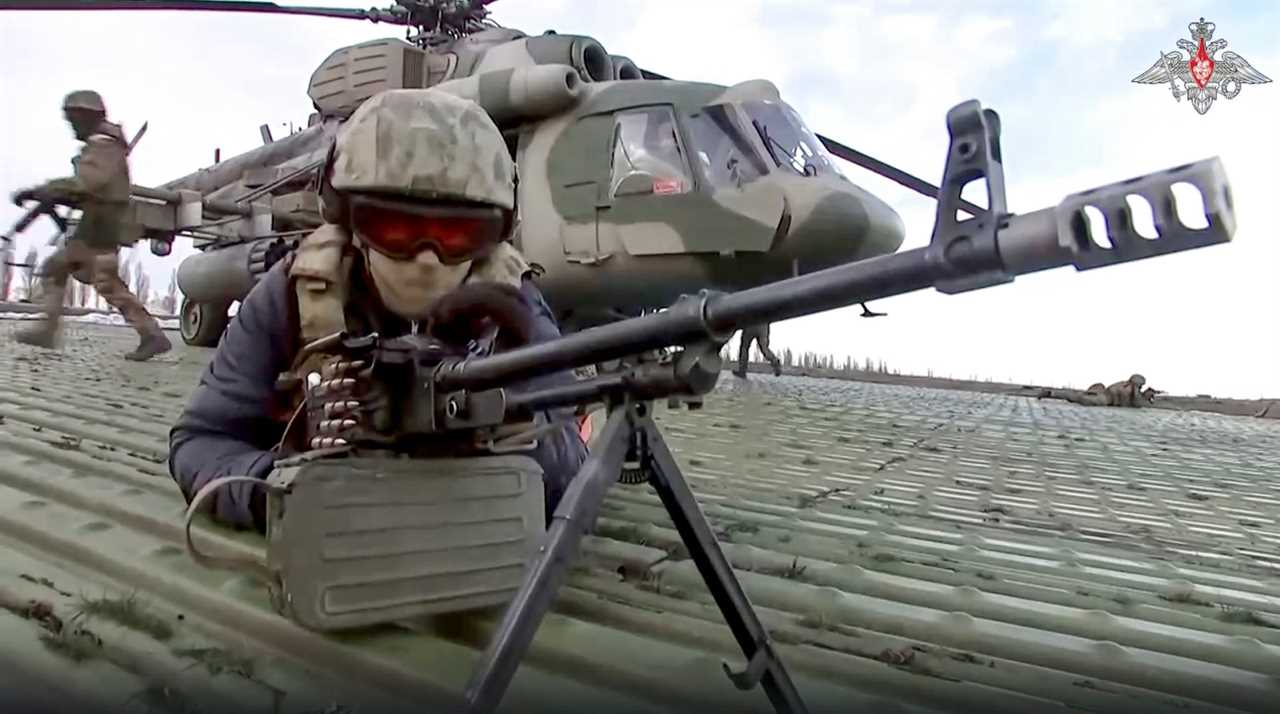Dogukan Keskinkilic/Getty Images
- Russia's attempt to seize Hostomel airport in 2022 was part of a "well-established playbook."
- "Appreciation of this playbook is key for states who might find themselves in the crosshairs," experts wrote.
- Even though Russia may dwarf a small state, that doesn't guarantee a successful airport seizure.
Here's some advice for nations who don't want Russian troops as uninvited guests: Guard your airport.
That's the recommendation from two American defense experts who point to a pattern in Russian operations over the last 50 years: when the Kremlin wants to occupy another nation, it goes for the airport.
Russia's failed attempt to seize Kyiv's Hostomel airport at the start of the 2022 Ukraine invasion was part of a "well-established playbook," Kevin Stringer and Heather Gregg wrote in an essay for West Point's Modern War Institute. Moscow sent commandos and paratroopers to seize airports in Prague in 1968, Kabul in 1979 and Sevastopol in 2014, to facilitate an advance by ground troops invading across the border.
"An appreciation of this playbook is key for states who might find themselves in the crosshairs of future Russian aggression," the essay warned. The strategy can work with blistering speed as elite assault troops seize the airport to create an aerial beachhead. Air transports can then fly in reinforcements to expand the airhead, while waiting to link up with armored columns pouring across the border.
Russian operations follow a typical sequence, according to the essay. "Positioning conventional forces on the borders of the targeted country to amplify political pressure and organize for invasion; infiltrating special operations (Spetsnaz) units to prepare and spearhead the incursion; seizing a strategic airport through airborne units; and airlanding additional assault troops to secure the battlespace and decapitate the national government in conjunction with the already inserted special operations units."
The airport invasion force typically comprises a "special forces detachment to achieve surprise, followed with a battalion-sized element to pave the way for at least a brigade to follow on," Stringer, a retired US Army colonel, told Business Insider. A Russian brigade typically numbers about 4,000 paratroops.
The strategy doesn't always work. The 2022 Kyiv air assault was a fiasco: air strikes failed to suppress Ukrainian air defenses that shot down numerous helicopters, close air support for the airhead was lacking, and Ukrainian forces quickly counterattacked the 300 beleaguered paratroopers.
However, other Russian airport takedowns have been largely successful. The Prague attack helped Warsaw Pact forces to occupy Czechoslovakia with minimal fighting and casualties. The Kabul attack, which aimed to topple Afghan president Hafizullah Amin, was bloodier: Hundreds of Afghans, as well as KGB and Spetznaz commandos, died during an assault on the presidential palace that ended with Russian troops killing Amin. At Sevastopol, Spetznaz units (the notorious "little green men" in unmarked uniforms) seized two airfields in a mostly bloodless operation.

Russian Defense Ministry Press Service/AP Photo
Given that seizing airports has worked for Russia in the past, it's reasonable to assume the Kremlin will use similar methods against other potential targets, such as the Baltic States, Moldova or Georgia. But that's easier said than done for small nations with small militaries. "Russia may have its hands full in Ukraine right now, but adequately preparing for Russia's invasion playbook takes time," the essay said. "This, combined with Russia's pattern of invading a country and deposing its leadership, makes it critical for vulnerable countries to take measures to counter the threat. For countries like Moldova and Georgia, this preparation is no small feat, given that both have Russian troops already in their country, are relatively small, and are faced with a range of resource constraints."
The authors suggest several solutions that aren't ruinously expensive. The first is to deploy special military units to defend key airports. "The Ukrainians left elements of the 4th Rapid Reaction Brigade of the National Guard at the Antonov Airport, despite the overwhelming need for Ukrainian troops to confront the Russian invasion at its borders," the essay noted. "This unit of around three hundred troops succeeded in frustrating the Russian forces' seizure of the airport and rendered the airstrip unusable, foiling subsequent Russian efforts to land forces and seize the capital."
Stringer points to a special airport defense regiment that Switzerland stationed at Zurich Airport during the Cold War, as a good model. "It was a brigade-sized element of approximately 3,000 personnel, primarily local reservists on standby. It consisted of four operational battalions armed with machine guns, 81-mm and 60-mm mortars, armored personnel carriers with 20-mm cannon, and Stinger anti-aircraft missiles. Airport vehicles could be used to block the runway. I think this model would be both pragmatic and affordable for a small state today."
Even though Russia may dwarf a small state in military power, that doesn't guarantee a successful airport seizure. Lightly armed airborne troops have historically been vulnerable to anti-aircraft defenses as they fly in and counterattacks by the defender before they can organize a ground position. "If the defense is prepared, the Russians are vulnerable," Stringer said. "This vulnerability increases if they do not have air superiority over the airfield."
If Russian troops do manage to capture an airport, the defender's best option is "immediate counterattack to dislodge the assaulting force and block the runway in order to prevent reinforcement and expansion of the airhead," Stringer said.
The US and Europe can also assist vulnerable nations in defending their airports. "The United States military has several units dedicated to seizing or securing airstrips, particularly within the Army's 75th Ranger Regiment and Air Force special operations forces," the essay said. "These units could provide valuable training on how to plan for and disrupt a Russian assault on critical airports. Similar capabilities exist within European special operations and conventional forces, including countries with total defense plans, such as Finland and Sweden."
In addition, the US and Europe may also be able to provide intelligence warnings of Russian plans to capture airports. For example, before Russia's February 2022 invasion, the CIA reportedly warned Ukraine of plans to capture Hostomel Airport.
"Ultimately, at-risk states and the countries that advise and support them should aim to increase the costs for Russia to execute its invasion playbook," the essay concluded. "Understanding and delineating the sequence of events Russia has historically used to initiate a coup and devising countermeasures to thwart these actions may prove critical in defending against the next Russian invasion."
Michael Peck is a defense writer whose work has appeared in Forbes, Defense News, Foreign Policy magazine, and other publications. He holds a master's in political science. Follow him on Twitter and LinkedIn.
Read More
By: [email protected] (Michael Peck)
Title: Don't want Russia to successfully invade your country? Then do this.
Sourced From: www.businessinsider.com/how-small-countries-need-defend-airport-from-russia-2024-2
Published Date: Sat, 02 Mar 2024 11:00:02 +0000
.png)





